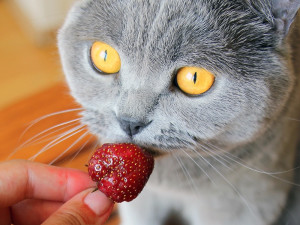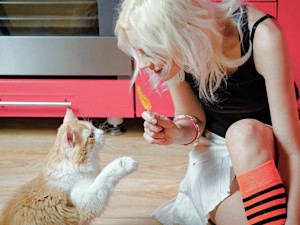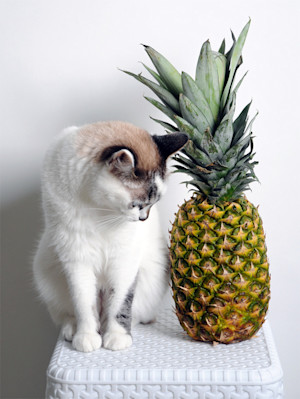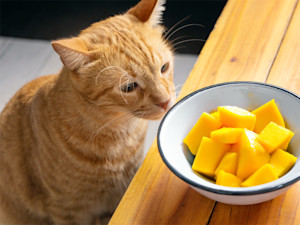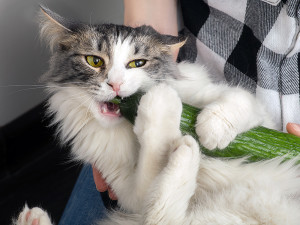Can Cats Eat Cherries?
Hopefully the answer is yes, because telling them no is the pits.
If you’re a fan of sweet, juicy, cherries, you may be wondering if you can share some with your cat. The short answer is that yes, in small amounts, the fruit of the cherry is safe for cats to eat.
It is not entirely good for them, however, and should be limited to small treats here and there. Read on to learn all about cherries for cats.
Nutrition facts about cherries for cats
Sweet cherries are the fruit of the Prunus avium tree. The fruit typically comes in shades of red to yellow with a single pit in the center. There are many varieties of edible cherries available, including Rainier cherries, Bing cherries, Montmorency cherries, sour cherries, Tulare cherries, and more. While they vary in their colors, flavors, and uses, with some being best for eating fresh and others used exclusively for baking, they tend to have similar nutritional profiles. Cherries are rich in fiber, vitamins, minerals, antioxidants, and natural sugars.
Are cherries good for cats?
Cherries are not considered good for cats since they lack a lot of the nutrients cats really need on the daily. Cats are obligate carnivores, so their bodies require a lot of nutrients that come from a whole prey diet, which is rich in protein, fats, and animal-based nutrients. Fruits like cherries are not part of cats’ typical diet, but they can provide some benefits, such as:
How much do you spend on your pet per year?
Fiber: Cherries are high in fiber, a non-digestible carbohydrate that is important for digestion. Fiber helps to bulk up the stool, create feelings of fullness, and prevent constipation.
Vitamins and Minerals: Cherries are rich in potassium and vitamin C. Interestingly, cats actually make their own vitamin C and do not need to get it from their diet, unlike humans. They can benefit from the potassium, which is important for many biological functions, including muscle contractions, nerve function, and maintaining normal blood pressure.
Antioxidants: Cherries are packed with numerous compounds including polyphenols, carotenoids, and anthocyanins, which have both antioxidant and anti-inflammatory properties. These compounds may prevent cell damage from oxidative stress, which can slow the effects of aging and protect against some cancers and chronic diseases.
Can cats eat any part of the cherry?
Cats should only eat the flesh of the cherry fruit, as the rest of the plant is technically considered to be toxic. This is because the rest of the plant, including the stems, leaves, and pits, contains a compound called cyanide.
Cyanide is toxic if consumed in large enough amounts and can cause respiratory distress, seizures, coma, or even death. And while that is all terrifying, the chances of your cat actually consuming enough of the plant to get very sick is highly unlikely. This is because the plant matter has to be ground up to activate the compound, and they have to eat a large amount of it in order to reach toxic levels of cyanide. And while they may not get cyanide poisoning, cats are still at risk for digestive upset including vomiting and diarrhea if they consume a lot of plant matter, so it is best to avoid it altogether.
The same is true of the pit; while cats should not consume the pits for many reasons, they will not get cyanide poisoning from pits that are intact. If the pit were ground up, or chewed up, then it could release cyanide. Given how hard the outer part of the pit is, it is very unlikely a cat could chew one up enough to be a problem. This is not the case for larger herbivores like horses, cows, and goats, who are all at risk from cyanide poisoning if they eat cherry plants, however.
Are cherries completely safe for cats?
Cherry fruits are safe for cats in moderation. There are a few important points to keep in mind if you are sharing cherries with your cat:
High-fiber content: Cherries are rich in fiber which is a good thing in small amounts. However, too much fiber can cause digestive upset including bloating, gas, or diarrhea. For cats that are not used to eating a lot of fibrous food, it is important to go slow and offer only a small amount at first.
Sugar content: Sweet cherries contain more sugar than cats typically need in their diet. And while the occasional few bites are ok, cats should not have excess sugar in their diet on the regular. As obligate carnivores, they do not metabolize sugars like we do, and are at risk for weight gain and related health problems like diabetes and arthritis if they consume a lot of sugary foods.
Choking hazards: Whole cherries can be difficult for cats to chew up, and can become choking hazards if your cat tries to swallow a large chunk. It is also important to remove the pit before sharing pieces of cherry with your cat as this can also be a choking hazard or even put some cats at risk for an intestinal blockage if they are swallowed whole.
The bottom line: Can cats eat human food?
Cats can eat some human foods, but it is also important to recognize that their nutritional needs differ from ours. As obligate carnivores, their bodies are designed primarily to eat whole prey type diets that are rich in protein, fat, and other animal-based nutrients. A cat’s typical diet is lower in carbohydrates, fruits, vegetables, and sugars than most omnivore’s diets, including humans. In order for your cat to obtain all of the nutrients they need, a complete and balanced cat food diet must be their primary source of food. If you do want to share the occasional table scrap with your cat, try to focus on plain, lean proteins and fruits or vegetables that are low in sugar.
Be sure to keep in mind that there are also some foods that are perfectly safe for us but can be toxic to cats. If you are unsure whether or not a food is safe, double check with your veterinarian or a pet poison hotline before sharing. Finally, many indoor cats really struggle with maintaining an active lifestyle and may be more at risk for weight gain if they are sedentary and also overfed. Be sure to limit treats and table scraps to less than ten percent of your cat’s total diet and incorporate fun, enriching activities into your cat’s routine to keep them active and engaged at the same time.
Other foods that are good for cats
Plain, cooked tuna can be a protein-rich snack for cats.
Berries like blueberries tend to have less sugar than other fruit, making them a good choice for an occasional snack.
Yogurt can also be a good snack in small portions as long as the ingredients are all kitty-safe.
Other foods that are dangerous
Grapes and raisins are potentially toxic and should be kept out of reach.
Chocolate also contains toxins for cats and cannot be shared.
Garlic and other plants in the Allium family are also toxic to cats.
FAQs (People also ask)
How many cherries can a cat eat?
Cherry consumption should be limited to a few bite sized pieces as too many may cause diarrhea.
Is it OK to give cats cherries?
Cherry fruit is not toxic and safe in small amounts.
Why do cats like cherries?
Cats may like the juicy, soft texture of cherries.
Can cats eat cherries?
Cherry fruit is safe as a small, occasional treat.
Can cats eat any part of the cherry?
Cherry pits, stems, and leaves are potentially toxic and should not be eaten by cats.




